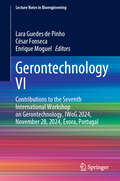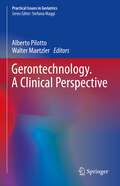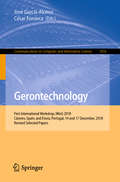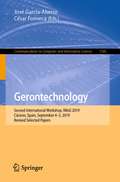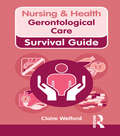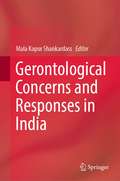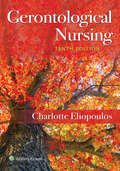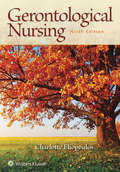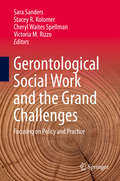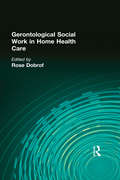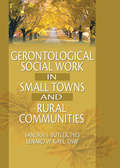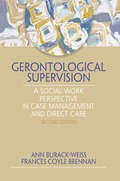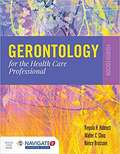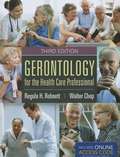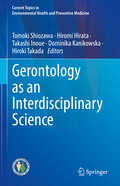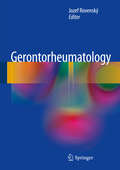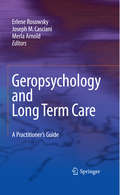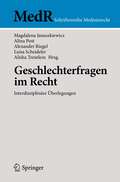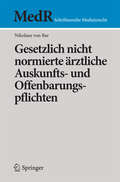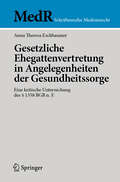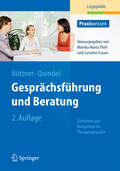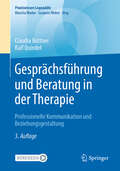- Table View
- List View
Gerontechnology VI: Contributions to the Seventh International Workshop on Gerontechnology, IWoG 2024, November 28, 2024, Évora, Portugal (Lecture Notes in Bioengineering)
by César Fonseca Enrique Moguel Lara Guedes de PinhoThis book gathers peer-review contributions to the 7th International Workshop on Gerontechnology, IWoG 2024, held on November 28, 2024, in Évora, Portugal. They report on cutting-edge technologies and optimized workflows for promoting active aging and assisting older adults at home, as well as in healthcare centers. They discuss the main challenges in the development, use and delivery of health care services and technologies. Besides proposing solutions for improving monitoring and management of health parameters and age-related diseases, the chapters also describe approaches for helping seniors in their daily tasks and facilitating their communication and integration with assistive technologies. All in all, this book provides health professionals, researchers, and service providers with extensive information on the latest trends in the development and application of gerontechnology, with a special emphasis on improving quality of life and social integration of the elderly.
Gerontechnology. A Clinical Perspective (Practical Issues in Geriatrics)
by Alberto Pilotto Walter MaetzlerThis book aims at disseminating information and knowledge in Gerontechnology, a topic that is still considered a specific area of interest for techno-experts (i.e. informatics, engineers, bio-engineers, bio-statistics, etc.) while there is a relatively low diffusion of technological expertise among clinicians and other health professionals who are involved in the care of older people. In many parts of the world, average life expectancy is rising consistently, and at the same time technology is developing at a dramatic pace. This means having completely new options for the diagnosis, treatment and follow-up of diseases and disabilities of older people but also a new challenge to improve the quality of life by promoting an active and healthy aging at population level. This book explores the technical developments that are beginning to change the management of diseases and disabilities of geriatric patients. These include advanced Information and Communication Technologies (ICT), i.e. the new online services in healthcare and electronic medical-health records, Assistive Technologies (AT), i.e. behavior and motility monitoring sensorial tools, smart homes tools and telemedicine tools as well as Human–Computer Interaction technologies (HCI), i.e. robots for supporting people with mobility or cognitive limitations, humanoid robots, exoskeletons and rehabilitation robots. The Work is divided into three main parts: 1) Technology in a world of aging people, 2) Clinical applications of technologies in older people, and 3) Older people and technologies interaction including privacy issues, acceptability of technologies by older people and education and training of healthcare professionals in gerontechnology. The book will be an invaluable tool for geriatricians and other health professionals who are involved in the care of older people.
Gerontechnology: First International Workshop, IWoG 2018, Cáceres, Spain, and Évora, Portugal, 14 and 17 December, 2018, Revised Selected Papers (Communications in Computer and Information Science #1016)
by José García-Alonso César FonsecaThis book constitutes the thoroughly refereed post-conference proceedings of the First International Workshop on Gerotechnology, IWoG 2018, held in Cáceres, Spain on December 14, 2018, and in Évora, Portugal, on December 17, 2018. The 24 revised full papers along with 8 short papers presented were carefully reviewed and selected from 71 submissions.The papers are organized in topical sections on knowledge management for health: context, cognition, behavior and user modeling; technologies to increase the quality of life of the elderly population; Internet of Things (IoT); smarts technologies and algorithms for health; monitoring and management of chronic and non-chronic diseases;solutions for active aging, social integration and self-care; health interventions to support caregivers of elderly people; public health initiatives.
Gerontechnology: Second International Workshop, IWoG 2019, Cáceres, Spain, September 4–5, 2019, Revised Selected Papers (Communications in Computer and Information Science #1185)
by José García-Alonso César FonsecaThis book constitutes the thoroughly refereed post-conference proceedings of the Second International Workshop on Gerotechnology, IWoG 2019, held in Cáceres, Spain, in September 2019. The 24 revised full papers along with 11 short papers presented were carefully reviewed and selected from 77 submissions. The papers are organized in topical sections on smart technologies and algorithms for health; technologies to increase the quality of life of the elderly population;Internet of Things (IoT); solutions for active aging, social integration and self-care; monitoring and management of chronic and non-chronic diseases; health interventions to support caregivers of elderly people; public and other health initiatives.
Gerontological Care (Nursing and Health Survival Guides)
by Claire WelfordAs the world population ages and people live longer, nurses and healthcare workers, no matter what area they work in, will encounter older people. This guide aims to provide you with the basic but fundamental knowledge you will need to care for older people.
Gerontological Concerns and Responses in India
by Mala Kapur ShankardassThis book discusses gerontological issues and challenges impacting the quality of life of older people in India. The chapters provide different disciplinary insights ranging from sociology, anthropology, psychology, health sciences, social work, demography, gender, and legal perspectives. The chapters are written by experts and practitioners in the field bringing focus to new gerontological insights from an academic and an empirical perspective. It engages the reader with the growth of different branches of gerontology along with concerns faced by older people. It brings attention to concerns related to ageing of the population in different parts of the country, such as among the tribes, the LGBT community, and conflict zones. It highlights gender aspects related to health care and discusses policy responses, strategies to empower older persons, the role of voluntary organizations, issues related to caregiving and family bonding, and aspects of social protection for the older people. It offers a valuable resource for researchers, academics, practitioners, and policymakers in the areas of gerontology, demography, and sociology, as well as all those interested in the study of ageing populations.
Gerontological Nursing
by Charlotte EliopoulosGerontological Nursing, Tenth Edition focuses on the content that students need to know for effective practice, offering engaging, evidence-based coverage of the aging process, factors contributing to healthy aging, and unique aspects of disease presentation and management in older adults. The tenth edition retains the text’s acclaimed holistic approach and logical overview of the aging process, with updated content throughout to help students confidently care for an increasingly diverse population. This edition also includes Next Generation NCLEX®-Style Case Studies and Questions, which help students review important concepts and practice for the next generation NCLEX®, as well as Unfolding Patient Stories that correlate directly to simulated patient scenarios in vSim® for Nursing for enhanced preparation for practice.
Gerontological Nursing: Care Of The Older Adult (Coursepoint Ser.)
by Charlotte EliopoulosPrepare your students for successful gerontological practice! Focusing on the content that students need to know for effective practice, this text offers engaging, evidence-based coverage of the aging process, factors contributing to healthy aging, and unique aspects of disease presentation and management in older adults. Updated to help students meet the challenges of this increasingly diverse population, the ninth edition retains its acclaimed holistic approach through insightful coverage of the psychosocial, legal, ethical, and spiritual elements of patient care. HIGHLIGHTS OF THE NINTH EDITION Concept Mastery Alerts improve students’ understanding of potentially confusing topics, as identified by Lippincott’s adaptive learning powered by prepU. Consider This Case, Bringing Research to Life, Practice Realities, and Critical Thinking Exercises make concepts come alive and show students how the concepts they are learning are applied in real-life contexts. In-text learning aids—including bolded key terms, communication tips, points to ponder, key concepts, and chapter summaries—help students master important material. Nursing Diagnosis Highlights provide overviews of common diagnoses, covering causes to interventions in an easy-to-understand manner. Nursing Care Plans outline diagnosis, goal, and action for selected health conditions, giving students practical models for effective health care planning. Assessment Guides walk students through general observation, the history-taking interview, and the physical examination. To develop highly capable nurses and promote sound clinical reasoning skills, the ninth edition is supported by Wolters Kluwer’s suite of best-in-class digital solutions, including prepU (adaptive quizzing), DocuCare (educational EHR software), and vSim (realistic virtual simulations co-developed by Laerdal Medical and Wolters Kluwer, which are based on the NLN ACE.S Unfolding Cases).
Gerontological Social Work and the Grand Challenges: Focusing on Policy and Practice
by Sara Sanders Stacey R. Kolomer Cheryl Waites Spellman Victoria M. RizzoThe growing number of older adults in the United States poses a significant challenge to families, healthcare systems, mental health services, and many other caregiving groups. Using the Grand Challenges for Social Work initiative as a framework, this text evaluates critical policies and issues pertaining to older adults, identifying both the overall systemic inequalities currently working against older adults as well as specific areas that require updated policies and interventions. It calls for active attention to the implementation of science-based research, policy, and practices to promote health and well-being. Among the topics addressed: Family violence against older adults Disaster planning and preparedness Building financial capability for aging families Health needs of incarcerated older adultsClosing the gap in healthcare services for older adultsSocial isolation and its effects on mental health and well-being A useful gerontology resource for students, social work scholars, and practitioners, Gerontological Social Work and the Grand Challenges advocates for justice and equal opportunity for older adults, and highlights important social issues that must be urgently addressed in the near future.
Gerontological Social Work in Home Health Care
by Rose DobrofA variety of programs are described in this volume illuminating innovative approaches to service delivery.
Gerontological Social Work in Small Towns and Rural Communities
by Sandra Butler Lenard W KayeLearn the skills you need to work with geriatric populations in rural areas! Gerontological Social Work in Rural Towns and Communities provides a range of intervention and community skills aimed precisely at the needs of rural elders. This book fills a gap in the literature by focusing on the specific practice concerns for social workers assisting older adults in rural areas, including the aging experience, social worker skills, professional functions, working with special populations, and health and long-term care concerns. This valuable resource will benefit social workers, gerontologists, allied health professionals in rural areas, health and human services administrators and managers. Gerontological Social Work in Rural Towns and Communities explores the challenges social workers need to overcome when working with the elder community in rural areas. This book&’s significance to social workers will only increase as more adults choose to live and grow old away from the cities. Experts in the field suggest strategies to overcome barriers in planning and providing services such as: a longer distance for the elderly to travel to use social service centers a narrower range of available services in the local area increased poverty levels for the elderly a stronger dependency by elderly on family rather than public assistance This book is divided into five sections: Rurality and Aging-introduces the concept of rurality and examines the demographics of aging from a rural perspective Practice Dimensions of Social Work with Rural Elders-includes clinical practice models, intervention and advocacy techniques, program planning, and marketing approaches Special Populations-gives attention to four special population groups: indigenous elders, African-American older adults, elderly Latinos, and disabled elders Special Issues Pertaining to Rural Elders-covers five essential issues for rural gerontological social workers: health promotion, older workers and retirement preparation, aging in place, specialized housing, and ethical practice Training and Policy Recommendations-future training and education recommendations for social workers are explored, as well as service capacity building, the aging network, and the future of long-term care While a variety of theoretical perspectives are explored in Gerontological Social Work in Rural Towns and Communities, the book&’s empowerment orientation and strengths-based approach will enhance your abilities to improve quality of life for elderly individuals in rural communities. Each chapter contains a comprehensive review of the literature on the subject it addresses, and several chapters include tables and graphs to further establish their revealing empirical findings. An appendix provides additional sources to turn to for more information.
Gerontological Supervision: A Social Work Perspective in Case Management and Direct Care
by Ann Burack Weiss Frances C. BrennanThe growing population of aging Americans is bringing with it thousands of new workers into agencies serving the elderly each year. Now, the need for supervisors to administer and train staff in programs for older persons is increasing as well. This is a practical, "how-to" guide for the supervision of case managers, personal care providers, and interns working in community services and long-term care of ill or disabled older persons. This updated edition expands its focus by offering the latest, up-to-date ideas and proven "practice wisdom" for handling many of the field’s most common problems. Filled with direct and composite case examples, this useful guide looks at concerns central to the changing field of practice. Part one gives an overview of the social work perspective. Parts two and three consider practice and administrative issues. Supervision of interns is covered in part four, and part five expands the scope of original edition by discussing the similarities and differences between home care and long-term care settings. Chapters include coverage of: dual emphasis on person and environment treatment with dignity and respect stages of helping, learning, and teaching negotiating the balance between dependence and independence styles of learning and teaching tuning in and anticipatory empathy assessment, case planning, on-going work, and termination empowerment, mediation, and advocacy the supervisor as "middle management" staff development the supervisory conference and recording requirements evaluation in group supervision home care residential care Gerontological Supervision is an invaluable resource for supervisors with or without MSWs and RNs, as well as case managers, personal care providers, interns, and educators and students in social work.
Gerontology For The Health Care Professional
by Regula H. Robnett Walter C. ChopEach new print copy includes Navigate 2 Advantage Access that unlocks a comprehensive and interactive eBook, student practice activities and assessments, a full suite of instructor resources, and learning analytics reporting tools. Gerontology for the Health Care Professional, Fourth Edition is a comprehensive, practical text covering the evolving field of gerontology, developed for healthcare students and professionals. Written by experts across many health disciplines, this text presents an up-to-date and realistic assessment of the aging process. Gerontology for the Health Care Professional, Fourth Edition begins with a review of demographic trends and continues with an overview of key topics such as the physiology, pathology, pharmacotherapy, nutrition, communication, and social concerns related to caring for older patients. This interprofessional resource concludes with future concerns for an aging society and includes an epilogue encouraging all health care professionals to embrace patient or client advocacy, especially for older adults. With new case studies, review questions, and interactive activities, this accessible resource will provide an active learning experience for all health professions students.
Gerontology For The Health Care Professional
by Regula Robnett Walter ChopGerontology for the Health Care Professional, Third Edition is a comprehensive, practical text covering the evolving field of gerontology, written for health care students and professionals. Written by experts across many health professions, Gerontology for the Health Care Professional, Third Edition presents an up-to-date and realistic view on the aging process. With topics presented in an introductory fashion, this book covers all the important aspects of aging and instills an appreciation for the multidimensional aspects of aging for those who are working with and caring for elderly patients or clients. Each chapter includes objectives, chapter outlines, cast studies, multiple-choice review questions, and learning activities. <p><p> The Third Edition begins with chapters on different aspects of the aging process. Later chapters explore various issues that are of primary importance to the older population. This comprehensive, accessible text concludes with the future concerns of an aging society. There is also an epilogue encouraging all health care professionals to embrace patient or client advocacy, especially for older adults.
Gerontology as an Interdisciplinary Science (Current Topics in Environmental Health and Preventive Medicine)
by Takashi Inoue Hiromi Hirata Hiroki Takada Tomoki Shiozawa Dominika KanikowskaThis book presents the latest evidence-based approach in diagnosis and management of the aging of both individuals and society from a gerontology perspective. Amid significant demographic changes such as aging and longevity, one crucial concern is how to live a long healthy life and how community and company can support it. Thus, this book aims to educate society on this vital issue and promote research that integrates the humanities and sciences that welcomes the elderly into an economic market and considers them the new social asset. The book is organized into three themed parts; Environmental Health, Culture/Society in Gerontology, and Preventive Medicine. Chapters provide easy-to-follow algorithms and critical points for each topic. With the study of preventive medicine and environmental medicine in hygiene, the interdisciplinary systems will be suitable for pioneering new academic fields and innovation. Gerontology as an Interdisciplinary Science is a must-have source of information for academics for environmental and occupational health worldwide. It is also a valuable resource for both new and established researchers and students who seek comprehensive information on care, welfare and health promotion for the elderly. Researchers in various fields, such as robot operation interface and emotion analysis using biological signals of the elderly, will value this book. It enriches the understanding for creators and technical staff for data science/data-based science of the bio-signal of the elderly.
Gerontorheumatology
by Jozef RovenskýThis book covers all aspects of the specialized field of gerontorheumatology, providing a complete overview of rheumatic and musculoskeletal diseases and related conditions in the elderly. The emphasis is particularly on pathogenesis, diagnosis, prevention, and treatment, including the latest advances in biological and pharmacological therapy and potential treatment side effects. The book will provide the reader with a keen awareness of the characteristic features, distinctive etiologies, and different courses of the various disorders of the musculoskeletal system in the geriatric population. Diagnostic and treatment considerations of special relevance in daily practice are highlighted, and the importance of comorbidities and their rheumatic consequences is also emphasized. The book will be of value for gerontologists, rheumatologists, internists, and rehabilitation physicians and will offer excellent guidance for general practitioners, who are typically the first to deal with disorders of the musculoskeletal system in elderly patients.
Geropsychology and Long Term Care
by Erlene Rosowsky Merla Arnold Joseph M. CascianiThe ever-increasing population of older adults residing in nursing homes and long-term care communities, as reflected in numerous demographic studies, point out a clear need for geropsychologists i.e., trained specialists in the field of aging and mental health, to meet the needs of this nation's older adults. This book will provide a needed resource for psychologists working in long-term care settings and those who wish to do so. Key outcomes include the provision of high quality psychological services for this important but neglected sector namely, people living in nursing homes, assisted living communities and other LTC settings. This text will be of great value to psychologists currently working in long-term care settings who have had graduate work in geropsychology, yet desire more in-depth and practical training. A second audience includes those individuals who may have a leaning towards expanding their professional activities in long-term care and are seeking additional preparation before doing more work with older adults. A third group is comprised of those individuals who are not psychologists, yet have had some training and coursework in aging and mental health.
Geschichte der Akademischen Lehrstätten, Lehrer, Lehrerinnen und Kliniken der Hals-Nasen-Ohren-Heilkunde, Kopf- und Hals-Chirurgie in Deutschland: Zusammengestellt von Stefan Plontke, Tilman Brusis, Konrad Fleischer und Hans Heinz Naumann
by Deutsche Gesellschaft für Hals-Nasen-Ohren-Heilkunde, Kopf- und Hals-Chirurgie e.V.,In diesem Band wird die Geschichte der Akademischen Lehrstätten, Lehrer, Lehrerinnen und Kliniken der Hals-Nasen-Ohren-Heilkunde und der Kopf- und Halschirurgie aller deutschen Universitäten von der Etablierung der Spezialkliniken an den deutschen Universitäten und Krankenhäusern bis in die Gegenwart nach ihren Städten geordnet dargestellt. Dies umfasst die strukturelle Entwicklung, die bauliche und personelle Ausstattung sowie die wissenschaftlichen und klinischen Schwerpunkte in den einzelnen Kliniken und Epochen. Alle ehemaligen und gegenwärtigen Lehrstuhlinhaber und Lehrstuhlinhaberinnen des HNO-Fachgebietes und ihre habilitierten Mitarbeiter und Mitarbeiterinnen werden mit ihren Arbeitsschwerpunkten und Verdiensten um die Weiterentwicklung des HNO-Faches vorgestellt. Im Anhang befinden sich Firmenportraits von Industrieunternehmen, die sich um die technische Entwicklung des HNO-Faches besonders verdient gemacht haben.
Geschichte, Theorie und Ethik der Medizin
by Wolfgang U. EckartGeschichte, Theorie und Ethik der Medizin auf dem neuesten Stand Das Lehrbuch für den Querschnittsbereich „GTE“: Es vermittelt die wesentlichen Grundlagen über Geschichte, Theorie und Ethik der Medizin spannend und anschaulich. Die verschiedenen Epochen der Medizingeschichte werden vielfältig beleuchtet und Brücken zu den aktuellen Herausforderungen in medizinischer Ethik und Theorie geschlagen. Der leicht verständliche Schreibstil vermittelt das Fach besonders lebendig und unterhaltsam. Der Inhalt - gezielte Prüfungsvorbereitung durch Zusammenfassungen und Definitionen - das kompakte und spannende Nachschlagewerk - umfangreiches Kapitel zu Ethik und Recht der Medizin auf dem aktuellen Stand- Ergänzungen zu den großen Seuchen inklusive extra Kapitel zur Corona-Pandemie Der Überblick für den Querschnittsbereich GTE: Lernen, schmökern, nachschlagen
Geschlechterfragen im Recht: Interdisziplinäre Überlegungen (MedR Schriftenreihe Medizinrecht)
by Magdalena Januszkiewicz Alina Post Alexander Riegel Luisa Scheideler Alisha TreutleinDieses Buch enthält interdisziplinäre Beiträge zum Thema Geschlecht und widmet sich schwerpunktmäßig dem aktuellen Thema der Trans- und Intergeschlechtlichkeit. Nach einem einführenden rechtshistorischen Beitrag wird die Geschlechterfrage aus kirchenrechtlicher Sicht beleuchtet. Ergänzt wird die Thematik durch einen Beitrag über Straftaten gegen die sexuelle Selbstbestimmung. Weitere Beiträge behandeln die Trans- und Intergeschlechtlichkeit aus medizinischer, verfassungsrechtlicher und zivilrechtlicher Perspektive und zeigen Reformbedarf in diesem Bereich auf.
Gesellschaften in der Krise: Praktiken, Diskurse und Wissensregime in Zeiten von Corona
by Helene Gerhards Debora Frommeld Karsten WeberDas Virus SARS-CoV-2 und die dadurch ausgelöste Coronapandemie haben die Gesellschaft in einen Krisenmodus versetzt: Die Coronapandemie hat tiefgreifenden Einfluss auf den Alltag von Subjekten in allen Lebenslagen genommen, gesellschaftliche Bedingungen verändert und institutionelle Veränderungen angestoßen. Ob das Tragen eines Mund-Nasen-Schutzes, die virtuelle Kommunikation als neuer Standard in Arbeitsumgebungen oder Regelungen zu Impfungen und öffentlichem Gesundheitsschutz – gesellschaftliche Praktiken und Diskurse haben sich verändert sowie Wissensregime etabliert, die einer genaueren multidisziplinären Analyse würdig sind. Der Band versammelt Beiträge zu Bereichen, die von einem krisenbedingten Wandel betroffen sind: Alter, Bildung, Emotion, Freiheit, Geschlecht, Gesundheit, Digitalisierung, Körper, Medizin und Versorgung sowie Sorgebeziehungen.
Gesetzlich nicht normierte ärztliche Auskunfts- und Offenbarungspflichten
by Nikolaus Von BarDieses Buch zeigt auf, wann Ärzte entgegen ihrer Schweigepflicht zur Mitteilung von Patientengeheimnissen verpflichtet sind. Nach derzeit geltender Rechtslage dürfen Ärzte in Einzelfällen ihre Schweigepflicht zum Schutz eines höherwertigen Rechtsgutes brechen. Das zu schützende Rechtsgut muss in der konkreten Situation gegenüber dem allgemeinen Persönlichkeitsrecht des Patienten überwiegen und dem zu schützenden Rechtsgut muss eine Gefahr drohen. Es obliegt grundsätzlich dem einzelnen Arzt darüber zu entscheiden, ob er den drohenden Schaden für das höherwertige Rechtsgut abwendet. Nicht zuletzt nach dem Absturz der Germanwingsmaschine im März 2015 kam die Diskussion darüber auf, ob Ärzte nicht viel häufiger dazu verpflichtet sein sollten, ihre Schweigepflicht zu brechen, um Dritte vor Schäden zu schützen.Der Verfasser dieses Werkes legt verschiedene zivilrechtliche Grundsätze dar, aufgrund derer Ärzten nicht nur das Recht, sondern die Pflicht zukommt, Patientengeheimnisse zu offenbaren. Diese allgemeinen Grundsätze werden an verschiedenen Fallgruppen angewendet. Wann ist ein Arzt beispielsweise dazu verpflichtet, einem Dritten die AIDS-Erkrankung eines Patienten mitzuteilen? War der Arzt des Piloten der abgestürzten Germanwingsmaschine dazu verpflichtet, die Depressionserkrankung des Piloten Dritten mitzuteilen? Haben Eltern ein Recht darauf, von einem Arzt zu erfahren, ob ihre minderjährige Tochter schwanger ist? Können Ärzte dazu verpflichtet sein, Prädispositionen für letale Erbkrankheiten an ihre Patienten zu offenbaren und haben diese ein Recht darauf, einer solchen Mitteilung aus dem Weg zu gehen? Und in welchen Fällen müssen Ärzte Kindern anonymer Samenspender die Identität ihrer biologischen Väter mitteilen? Diese Fragen werden in dem vorliegenden Buch – auch für Mediziner verständlich - beantwortet.
Gesetzliche Ehegattenvertretung in Angelegenheiten der Gesundheitssorge: Eine kritische Untersuchung des § 1358 BGB n. F. (MedR Schriftenreihe Medizinrecht)
by Anna Theresa EschbaumerDieses Buch beinhaltet eine ausführliche und kritische Untersuchung des mit dem Gesetz zur Reform des Vormundschafts- und Betreuungsrechts vom 4.5.2021 neu in das BGB eingeführten gesetzlichen Ehegattenvertretungsrechts in Angelegenheiten der Gesundheitssorge (in Kraft seit 1.1.2023). Basierend auf einer umfangreichen Auslegung der einzelnen Regelungsaspekte des § 1358 BGB n. F. (etwa Anwendungsbereich und Umfang der Befugnisse, aber auch das Verhältnis zu weiteren Rechtsinstituten zur Vertretung in Gesundheitsangelegenheiten) werden konzeptionelle Defizite des § 1358 BGB n. F. herausgearbeitet und damit einhergehende Probleme – rechtlicher als auch praktischer Natur – identifiziert. Weiterhin ist Gegenstand der Untersuchung, ob und inwieweit etwaige Unklarheiten und Schwächen der Neuregelung durch sorgfältige – ggf. verfassungskonform auszugestaltende – Auslegung reparabel sind. Schließlich werden Reaktionsmöglichkeiten des Gesetzgebers zum weiteren Verfahren mit der Norm aufgezeigt. Leserinnen und Leser erhalten einen umfassenden Überblick über das neue Ehegattenvertretungsrecht in dem grundrechtsintensiven Bereich der Gesundheitssorge und werden für die Herausforderungen im Zusammenhang mit der Anwendung des § 1358 BGB n. F. sensibilisiert. Das Buch richtet sich damit nicht nur an die juristische Leserschaft, sondern auch an Rechtsanwenderinnen und -anwender sowie an interessierte von der Neuregelung Betroffene – sowohl auf Behandlungs- als auch auf Patientenseite.
Gesprächsführung und Beratung
by Ralf Quindel Claudia Büttner Monika RauschEine einfühlsame und zielorientierte Kommunikation mit Patienten und auch mit Eltern junger Patienten ist meistens ausschlaggebend für den Behandlungserfolg. In dem Buch kommen alle für die logopädische Therapie wichtigen Themen zur Sprache. Ausgehend von Grundbegriffen und Anwendungskonzepten vermitteln die Autoren Techniken der Gesprächsplanung sowie der Gesprächsführung und veranschaulichen diese anhand von Situationsbeispielen. Neu in der 2. Auflage sind u. a Abschnitte zur Elternberatung und zur interkulturellen Kommunikation.
Gesprächsführung und Beratung in der Therapie: Professionelle Kommunikation und Beziehungsgestaltung (Praxiswissen Logopädie)
by Ralf Quindel Claudia BüttnerIn diesem Lehrbuch finden Sie für die Logopädie und Sprachtherapie alles rund um eine gelungene Gestaltung von Gesprächssituationen im Therapie-Setting: Es liefert die notwendigen Grundlagen aus der Kommunikationspsychologie und Psychologie, zur Gesprächsführung und bietet Gesprächsbausteine sowie Beratungskonzepte. Konkrete Fallbeispiele zu Gesprächen mit Kindern, Elterngesprächen sowie Konfliktsituationen helfen bei der praktischen Umsetzung; Literaturempfehlungen ermöglichen die Vertiefung der Inhalte.
